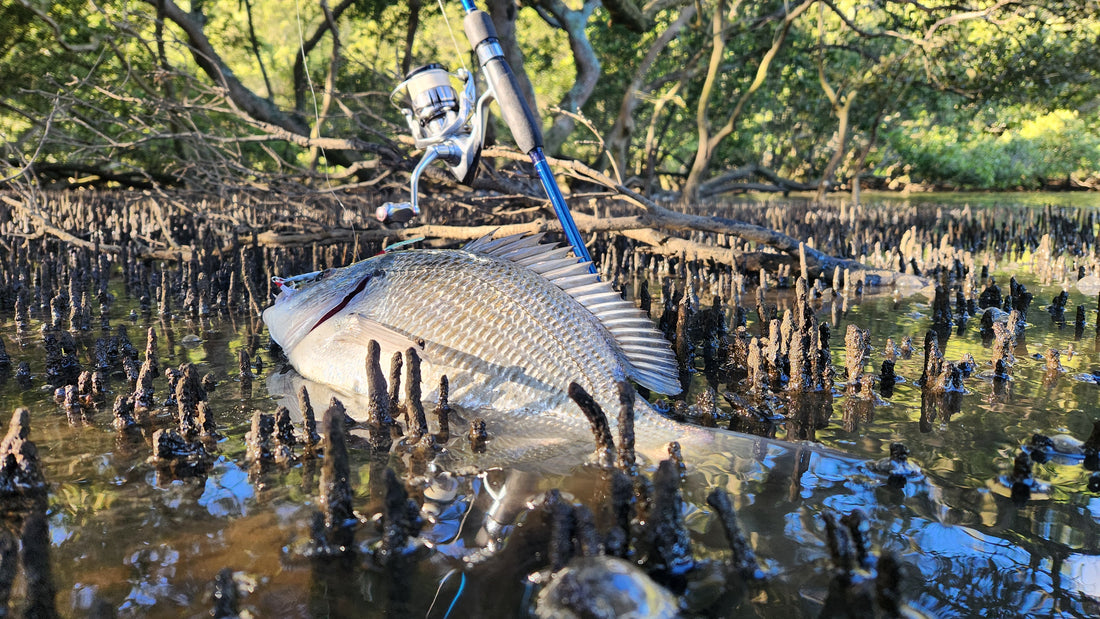
Micro Jigging Gear Guide
If you are looking to make sure you have the right gear to Micro Jig, this is the article for you.
Micro Jigging is a reasonably simple technique made better with the right gear. When getting started, ensuring you have appropriate gear will go a long way to having a good fishing experience and getting on to more fish!
To get started, think of your rod and reel as a system that needs to work together to get you the right fishing outcome.
To start with the Micro Jigging pack, there are lures from 7-15g and this is the range of gear you should use to get the best out of the pack.
|
Reel |
2500 size reel |
Shimano Stradic/Nasci/Miravel, Daiwa Kix, TD SOL, Revelry |
|
Rod |
2-4kg rod 7-8ft |
Daiwa, Atomic Arrowz, Shimano |
|
Main line |
6-10lb Braided line |
Anything will do, as long as it is braid! Mono will lead to tangles and poor casting performance |
|
Leader |
Fluor or Nylon mono Filament between 8-15lb |
Selection of leaders is up to you. When targeting fish that can be ‘leader shy’ like Bream, lighter is better. But when targeting bigger fish like Flathead it is a good idea to use a heavier leader, especially if you plan on lifting your catch out of the water. |
Other considerations with gear,
How much leader?
If you are tying an FG knot, 1 and a half rod lengths is plenty, you want the FG knot to come through the rod guides and stop at the latest before the guide closest to the spool (called a stripper guide). This knot position allows lots of leader and lower liklihood of wind knots.
If you tie a uni to uni knot, you are better not ‘casting through the guides’ i.e. when you cast, the knot should be hanging out of the end of the rod tip. 30cm is plenty in this configuration.
The FG knot with a long leader is superior as more leaders can give you more durability when landing or fighting a clever or stubborn fish. Braid will ‘pop’ when rubbed against something under tension, while leader material will give you slightly more resistance in the same scenario.
How to choose a rod?
Most rods with lure weight rating will cast much heavier lures than recommended without breaking, however the rod may not work as intended by the manufacturer. A general rule of thumb when jigging is that the tip of the rod can be ultra flexible and is there to work the lure, manage your line so you don't get tip wraps and hold little hooks in the fish's mouth.
When you move past the tip, to the second third onward, the rod should be stiffer, allowing you to make accurate casts, steer fish in, and work your lure with faster retrieve techniques.
Reel choice?
When you master casting these jigs, a 2500 size reel will have enough line to allow a long cast, with enough line leftover so a trophy fish can run 50 metres or so when your jig hits the water.
Regarding cost, get the reel you like and can afford. Low end reels from top manufacturers are excellent value, and if looked after will give you many years of service.
For ultra light jigging, anything that will hold 200 to 300m of your selected line is plenty.
Line Choice
There are multiple choices for line with advantages and disadvantages
Mono
The line is not suitable for this style of fishing, it is stretchy, limiting contact with the jig, the combination of the line’s memory and it’s tendency to twist will create knots and failed casts. Mono will also dramatically reduce your cast distance.
Braided line
There are mostly two varieties, 4 and 8 strand braids.
4 strand is slightly stiffer, meaning it can be better to use in windy conditions, and some say it is more abrasion resistant. It is generally cheaper and it’s only drawback is slightly reduced cast distance.
8 strand being made of more finer threads is more flexible which leads to better cast performance with less line resistance coming off the spool or through the guides. Due to being more flexible, it is more likely to knott during casting in windy conditions.
Optional gear
Landing net -
When fishing with light line from the shore or water craft, there is nothing worse than trying to land a fish without a net. A compact fold away fishing net that you can attach to your belt or bag is a necessity if you are landing a real trophy catch.
If you plan on taking pictures, the net also serves as a great place to keep the fish alive while you organise your phone for pictures.
Pliers -
When you land that fish, these jigs can be hard to dislodge without risking being hooked yourself. a pair of pliers may seem unnecessary but they could save you a nasty experience!
In conclusion, getting set up can look very different, and if you follow these guidlines you will be on the way to having a set up that works for you.
Happy Fishing!
